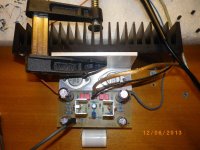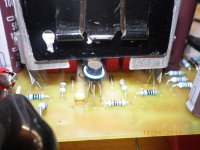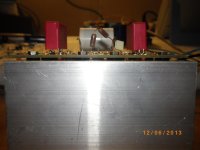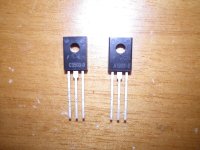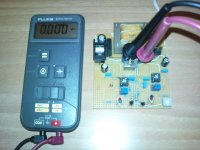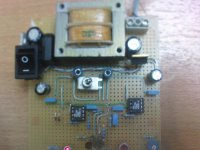Hi Paulo.
22pF has been the standard for some time. For dielectric choice I think a pair of silver-mica caps will be good.
Thanks Shaan🙂
shaan,
How would the peeceebee compare to the Death of Zen in a low
power application; specifically, in your opinion, powering a 108dB
efficient mid-range compression driver?
How would the peeceebee compare to the Death of Zen in a low
power application; specifically, in your opinion, powering a 108dB
efficient mid-range compression driver?
shaan,
How would the peeceebee compare to the Death of Zen in a low power application; specifically, in your opinion, powering a 108dB efficient mid-range compression driver?
Hi bruce.

I don't own any compression driver and my speakers are below 90dB. So predicting any amp's performance without experience with horn etc. is out of question.
I can, however, tell you that even at low level and with same medium sensitive speakers like mine, the DOZ and VSSA sounds completely different.
DOZ is very good at managing HF and excels at the mid range, i.e. the vocals are very pleasing and 'full' of life, credit goes to the dominant second harmonic character of its output. The bass is also very good and so is its 4R load management.
VSSA, on the other hand, shines on every part of the music, from kick drum to cymbals, equally. It lacks any inherent 'signature' that might influence the sound in any way, pleasing or disturbing. All that comes from the speaker is the truth, just 'that' exact thing that I wanted from it, i.e. detail, power, clarity and everything the music contains, including ocassional blunders that may well go unnoticed with DOZ due to it's masking effect on program material. VSSA is all about accuracy. Pure Music >Delivered< 😀
p.s. I love both DOZ and VSSA, because they are different, they are both CFB, and both good at doing their assigned jobs.
Used in some well regarded UK products like Magnum IA125. That was 25 years ago!
Used in some well regarded UK products like Magnum IA125. That was 25 years ago!
Yes, old project with Fets.
An externally hosted image should be here but it was not working when we last tested it.

Regards zeoN_Rider
2nd that... I have taken my "portable" version to a couple friends with completely different speakers, and unlike other kinds of amplifiers, this one sounds uniformly clear, at low to moderate power levels. You could say accurate, or transparent, if you prefer... 😀...VSSA, on the other hand, shines on every part of the music, from kick drum to cymbals, equally. It lacks any inherent 'signature' that might influence the sound in any way, pleasing or disturbing...
Also in general, at low power, amplifiers with a single output pair and good quality components seem to always sound better than amplifiers with 2 or more pairs. The imperfections which come about as a result of unmatched components in high power multiple-pair amplifiers become noticable at low power levels, (IMHO, at least). The fact that the VSSA circuit seems to have little or no crossover distortion also helps.
Look what you did Shaan , LC23 mA is too much for VAS, 12-15 mA is optimal. Input pair on the same temp (must be glued together), their gain match, VAS BJT gain match, PSU symetry if you use only resistors (not CCS) for input stage bias current, check them all, since all of them affects output DC offset. 🙂
500 KHZ under load 8 Ω and ,10mF input cap without comp at all as told Shaan
No oscilation at full wave with BD 139 -BD 140 at 15ma , offset 0-5mv
unmached BC550-560 and BD139 -140 ,910 KΩ resistor paralell 15kΩ
on 100Ω 205 mv -208mv to other on 470Ω 790 -805 mv to other
magic sound !!
Attachments
Last edited:
VSSA T03
Next step to put Zero gate res N ch and P ch and test at full load square wave to see if breaks at corners , and any osc
Also ι created a gap between boards and aluminum edge through an insulator so as not transfer the heat on board .
Anyway. I bought these transistors for better but I dont get good results offset and sound. Is it original ?
Zero both now. 😀
Next step to put Zero gate res N ch and P ch and test at full load square wave to see if breaks at corners , and any osc
Also ι created a gap between boards and aluminum edge through an insulator so as not transfer the heat on board .
Anyway. I bought these transistors for better but I dont get good results offset and sound. Is it original ?
Attachments
...500 KHZ under load 8 Ω... ...10mF input cap... ...without comp at all as told Shaan... ...No oscilation at full wave... ...magic sound !!
Zero oscillation without compensation, Proved. Thanks for the very symbolic post nikos, justifies my choice to eliminate those caps at VAS. The thread needed this.









Zero oscillation without compensation, Proved. Thanks for the very symbolic post nikos, justifies my choice to eliminate those caps at VAS. The thread needed this.

I like the way as you think!!
...I bought these transistors for better but I dont get good results offset and sound. Is it original ?
I think they aren't fake. However, the suffixes (D and E) makes me think that they may be at least 100 units apart from each other in hFE. Did you match the pair before using?
I think they aren't fake. However, the suffixes (D and E) makes me think that they may be at least 100 units apart from each other in hFE. Did you match the pair before using?
No. I do not match
The same and I think maybe the difference to be there. Νext days im trying to measure and match them if is it posible.
Ι use this circuit by Elektor .
Attachments
Last edited:
Nice! 😎Zero oscillation without compensation, Proved. Thanks for the very symbolic post nikos, justifies my choice to eliminate those caps at VAS. The thread needed this.
So, should I use the 22pF cap or no cap? 😕
I'm also confused about this: My KSA1381/KSC3503 are also D and E versions and about 80 hfe units apart. That's why I tought it would be better to use BD139/140. But I simulated with LTSpice both cases and the KSA's give me much lower THD. So, wich ones should I use?
Thanks.
Last edited:
VSSA T03
I think only if verify with scope
With SC3503 and SA1381 when pull out the 22pf total oscilation !!
Nice! 😎
So, should I use the 22pF cap or no cap? 😕
I'm also confused about this: My KSA1381/KSC3503 are also D and E versions and about 80 hfe units apart. That's why I tought it would be better to use BD139/140. But I simulated with LTSpice both cases and the KSA's give me much lower THD. So, wich ones should I use?
Thanks.
I think only if verify with scope
With SC3503 and SA1381 when pull out the 22pf total oscilation !!
Nice! 😎
So, should I use the 22pF cap or no cap? 😕
The caps are fixes for a possible problem. But don't fix it if it's not broken. I think you get the idea. 🙂
I'm also confused about this: My KSA1381/KSC3503 are also D and E versions and about 80 hfe units apart. That's why I tought it would be better to use BD139/140. But I simulated with LTSpice both cases and the KSA's give me much lower THD. So, wich ones should I use?
Thanks.
Simulators, AFAIK, can't drive a speaker. And usually real measurements differ to a large degree from simulated results. The problem you are facing wasn't evident in the sim, this makes the point clear enough. 🙂
Our good old BD pair is (in fact) smart enough fo its job in a CFB amp, like VSSA. The performance of a specific component depends on how well it is implemented in the project. IMO, VSSA utilizes this old couple to its best (being a CFB amp) and there is little, if nothing, more to gain from modern counterparts.
That said, I will encourage you to try every possibility. For it's the experience that matters most. The conclusion is that, if you don't feel uncomfortable with BD, then don't change it. 😀
It's only fun until you let the smoke out... then it's hilarious!
@Paulo: The tests being discussed here have to do with performance well above normal audio range. If you basically want to experiment with high frequency signals, this is great experience, not to mention fun. If you want a working amplifier to listen to... maybe not so much 🙄
If you have them use the Fairchild KSA1381/KSC3503 pair, if not use the faster version of BD139/140. Use the cap. It will not affect how the amplifier sounds, and it may save you some trouble later...
One thing I found today is that if you test with an unconnected/ungrounded signal cable which is long enough, the circuit can be made to oscillate very easily within the bandwidth of the input filter. I let some smoke out of the Zobel in the process, (pretty much expected at roughly 200KHz). Nothing is completely fool proof, I'll use 1W next time... 😀
P.S.: if you can, please post the simulation, I know I would like to see it, and other people might want to see it too.
@Paulo: The tests being discussed here have to do with performance well above normal audio range. If you basically want to experiment with high frequency signals, this is great experience, not to mention fun. If you want a working amplifier to listen to... maybe not so much 🙄
If you have them use the Fairchild KSA1381/KSC3503 pair, if not use the faster version of BD139/140. Use the cap. It will not affect how the amplifier sounds, and it may save you some trouble later...
One thing I found today is that if you test with an unconnected/ungrounded signal cable which is long enough, the circuit can be made to oscillate very easily within the bandwidth of the input filter. I let some smoke out of the Zobel in the process, (pretty much expected at roughly 200KHz). Nothing is completely fool proof, I'll use 1W next time... 😀
P.S.: if you can, please post the simulation, I know I would like to see it, and other people might want to see it too.
With SC3503 and SA1381 when pull out the 22pf total oscilation !!

Really? Wow!
Great CFB amp to listen to and to play with. Low parts count enables one to experiment and find the best compromise in practice. Ideal for school's technical lessons so youngsters can learn something about electronics.
I really cannnot imagine better six transistors schematic anywhere else.
I really cannnot imagine better six transistors schematic anywhere else.

- Home
- Amplifiers
- Solid State
- PeeCeeBee
